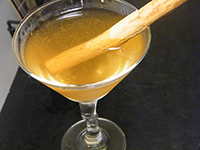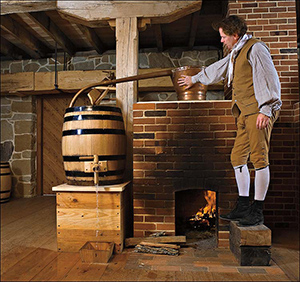 Recently, I was scouring the Internet for recipes for Apple Pie Cocktail, or at least something similar. There turned out to be a ton of drink recipes that were nothing at all alike. Before I finally came up with a concoction that satisfied my original quest, I started experimenting with some of the liquors and mixers I had compiled into a list of potential ingredients. What I accidentally came up with is a brand new drink that I am now dubbing the Sacramento Cider. This mixed drink tastes just like an alcoholic version of mulled cider, and I’m excited to share our Sacramento Cider recipe with you today.
Recently, I was scouring the Internet for recipes for Apple Pie Cocktail, or at least something similar. There turned out to be a ton of drink recipes that were nothing at all alike. Before I finally came up with a concoction that satisfied my original quest, I started experimenting with some of the liquors and mixers I had compiled into a list of potential ingredients. What I accidentally came up with is a brand new drink that I am now dubbing the Sacramento Cider. This mixed drink tastes just like an alcoholic version of mulled cider, and I’m excited to share our Sacramento Cider recipe with you today.
Sacramento Cider

- 2 oz apple cider
- ½ oz green apple vodka
- ½ oz vanilla vodka
- 1 oz apple schnapps
- ½ oz spiced rum
- Splash of Goldschläger
- ½ tsp cinnamon
- Garnish (optional)
In a cocktail shaker filled with ice, pour all your liquor ingredients, the apple cider, and the cinnamon. Shake and strain into a cocktail glass. If you want, garnish the cocktail with a cinnamon stick, apple chip, or wedge of green apple. Serve and enjoy!
I use 99 Apples for the apple schnapps, you can use the Sour Apple Pucker schnapps if that’s what you have on hand, but it might give your drink a green tint. I just prefer to keep it looking like cider, plus the 99 Apples gives the drink a little more oomph. Regular or vanilla vodka can be substituted for the green apple vodka if you don’t feel like buying a bottle of liquor for just one drink. I used Smirnoff for the apple vodka; I think it would be cool to try it with Absolut Orient Apple and see how that influences the taste if the drink.
There’s a few ingredients in this particular drink. I would give yourself about three minutes to mix one up. I like the Sacramento Cider cocktail as an alternative to hard cider. It works well for when you want an apple tasting drink, but not something as tart as an Appletini.
The History of Hard Cider in America
Most people today have no idea how intertwined hard cider was into daily life in Colonial America. English settlers brought apple seeds to North America when they first settled here in the 1600s. Back in England, apple orchards were set aside almost solely for the production of hard cider. Wine was more of a luxury, cider was everyone’s drink of choice. When I say everyone drank hard cider from breakfast to evening, I mean men, women, and children… even infants drank mulled cider at night before bedtime!
 Fast forward to the Colonial days, and the early Americans brought their traditions with them. Vast orchards were planted on the East Coast, and cider’s popularity continued. However, because of the way the colonies were set up and the trading laws, people could make cider at home, but had to drink imported English hard cider at local taverns. To add insult to injury, colonists were triple-penalized on their cider consumption: they had to trade only with England, paid to have English ships transport it there, and paid tax on the imported cider. Many historians believe that during the Boston Tea Party, the rebellious colonists chose to trash the tea and save the kegs of cider for themselves later.
Fast forward to the Colonial days, and the early Americans brought their traditions with them. Vast orchards were planted on the East Coast, and cider’s popularity continued. However, because of the way the colonies were set up and the trading laws, people could make cider at home, but had to drink imported English hard cider at local taverns. To add insult to injury, colonists were triple-penalized on their cider consumption: they had to trade only with England, paid to have English ships transport it there, and paid tax on the imported cider. Many historians believe that during the Boston Tea Party, the rebellious colonists chose to trash the tea and save the kegs of cider for themselves later.
The legendary Johnny Appleseed continued to spread apple orchards West, no doubt so that settlers could enjoy their favorite fermented beverage. Slowly, the bloom on the rose began to fade for the glory days of cider. Some historians theorize that it was the urbanization of the country, along with the growing German and Irish immigration from Europe that turned the tide of alcohol preference towards beer and whiskey, and away from cider. What we do know is that the dark days of the Prohibition Era killed hard cider consumption dead for many decades. It wasn’t until the 1990s that cider micro batches and larger companies such as Gallo began to lead the resurgence of hard cider production in this country once more.
 Our FNDC recipe for Sacramento Cider uses rum and other liquors to enhance non-alcoholic apple cider. Although our in-house bartenders don’t ferment apple juice from scratch, the practice of spiking hard cider with rum was very common in feudal England and Colonial America. Today, brands such as Woodchuck, Hornsby’s, Wyder’s, Magner’s, and Original Sin continue the great American heritage of fermenting hard cider in the traditional manner, and they are all worth a taste.
Our FNDC recipe for Sacramento Cider uses rum and other liquors to enhance non-alcoholic apple cider. Although our in-house bartenders don’t ferment apple juice from scratch, the practice of spiking hard cider with rum was very common in feudal England and Colonial America. Today, brands such as Woodchuck, Hornsby’s, Wyder’s, Magner’s, and Original Sin continue the great American heritage of fermenting hard cider in the traditional manner, and they are all worth a taste.







